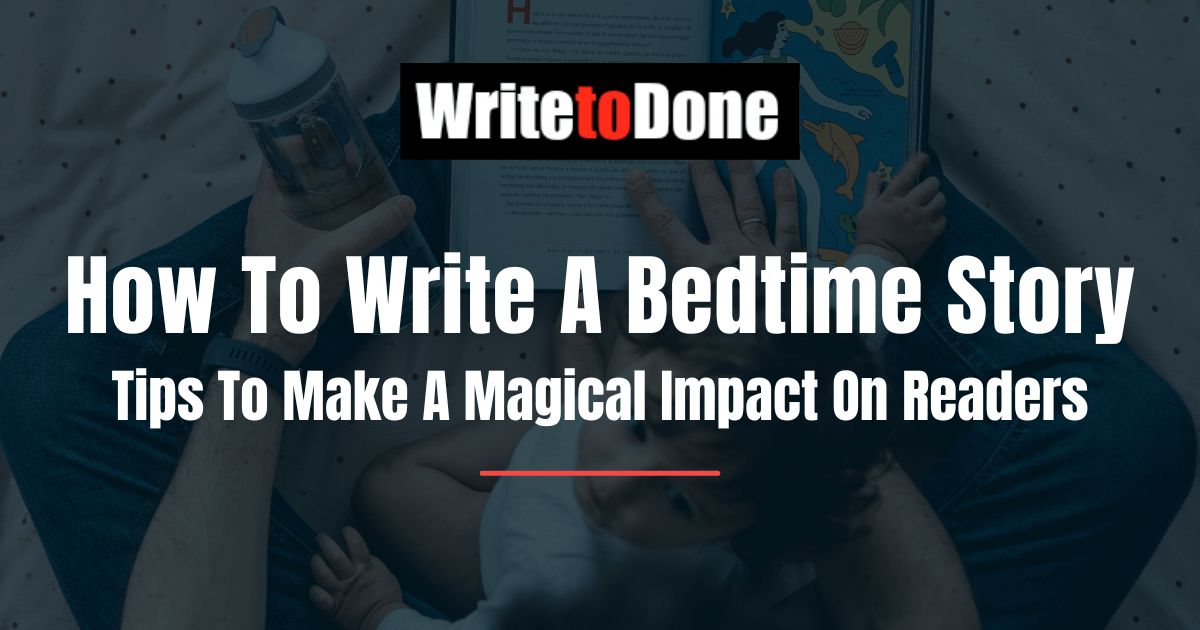If you want to learn how to write a bedtime story, you have a great goal. From children to adults, bedtime stories are a loved pastime.
Whether it’s the three-year-old asking you to read their favorite one, or a sleep app for adults with a slow, sleepy voice telling you a story, stories for bed are still in vogue and we don’t see them leaving anytime soon.
With this in mind, it’s crucial to not just ask how to write a bedtime story, but define what to include in this sub-genre, study a guide, and of course, look through famous examples. When learning how to write a bedtime story, it’s those tried and true examples that can make all the tips finally make sense.
So, if you’re ready, let’s get started by making sure we’re all on the same page.
What Is A Bedtime Story?
A bedtime story is a story that is read privately, read to another, or recounted to another before bedtime. Often, bedtime stories are helpful to encourage children to sleep, help them wind down, and show how the character in the book goes to bed…and so should they.
However, bedtime stories are not just for kids! A recent analysis showed high anxiety impacting 41% of US adults.
The same survey stated that, “A 58% majority of those ages 18 to 29 have experienced high levels of psychological distress at least once across four Center surveys conducted between March 2020 and September 2022.”
Apps such as Calm, Moshi (geared for kids), and Yours are all geared to help individuals get to sleep, despite the constant ingestion of news and other information that inundate us on a daily basis.
With this in mind, learning how to write a bedtime story does not just need to be a hobby or one-off goal. Today, studying exactly how to write a bedtime story can actually be a step toward helping listeners get the sleep they so desperately need.
How To Write A Bedtime Story: Essential Info
So now that we know the importance of bedtime stories, especially for children and adults today, how do we write a bedtime story? There are several key factors to keep in mind.
#1 – Don’t Forget About Length
Particularly with bedtime stories for children, length matters. You want your story to be long enough to engage them and get them tired, but short enough that they don’t lose attention or begin to fidget, ready to go do something else.
Depending on the age group you write for, you can search word counts in your search engine of choice, or reach out to fellow writers as well.
#2 – Formatting Your Story For Kids
How to write a bedtime story in a way that is effective largely comes down to formatting. Children need to engage with the story. Consider using the following options to draw in your young listeners:
- Primary colors
- Interactive pages
- Familiar places and characters
These options will aid both the reader as they seek to engage their child, and the child too.
#3 – Keep An Engaging Tone
Along with formatting, keeping an engaging tone in your story is paramount in learning how to write a bedtime story. For instance, you could write about a lost puppy finding his way home just in time for bed. Make the tone engaging by employing onomatopoeia, similes, and personification.
#4 – Be Sure To Teach A Lesson
Never miss the opportunity to teach a lesson when learning how to write a bedtime story. Whether you want to teach something as simple as the importance of tidying up before bed or as complex as being obedient to mom and dad, a bedtime story is a great opportunity.
Step By Step Guide
Now, how to write a bedtime story, the practical side! First, put yourself in your reader’s (or likely listener’s) shoes. As a child, what would engage you yet also help you go to sleep by the last page?
Second, choose a happy theme and plot. What we fill our minds with before bed matters, and for impressionable children, the same is true. What kind of plot can you write that is both engaging but also uplifting?
Third, choose your protagonist. What type of character will the child most identify with or find fun to learn about? Whether it’s another young child or a talking animal, who you choose as your hero will determine the viewpoint from which you write your story.
Fourth, refuse the urge to include too many peripheral characters. The goal is to help children go to sleep, not overwhelm them with a large cast of characters.
Fifth, remember that you only have a brief amount of time to portray your protagonist, tell your story, and get the child to sleep. Make sure, just like you do in fiction, to start your bedtime store in medias res, in the middle of something exciting.
Famous Examples
Whether you were the kid who fell asleep watching TV or the one begging for just one more bedtime story, you may recognize some of these titles. When learning how to write a bedtime story, it is helpful to look at examples of books that did well.
Famous examples can act as a template of inspiration teaching us:
- Plots that work
- Timeless characters
- How to capitalize on word count
Check out the following examples and let them inspire you as you begin your journey of learning how to write a bedtime story!
#1 – “Goldilocks and the Three Bears”
One of the classic fairy tales, this story is said to have originated in 19th century Britain. When a little girl with golden locks stumbles upon an empty house, she decides to go inside, eat their food, sit in their chairs, and snuggle up in their beds. Of course, when the three bears return home Goldilocks runs away.
#2 – “The Ugly Duckling”
A Danish fairy tale, written in 1843, this story follows the unlikely hero, the Ugly Duckling. The poor ugly duck is made fun of, abandoned by his family, and he has to spend a whole year searching for home. When he grows into himself and finally looks at his reflection, realizes he’s a swan.
#3 – “The Boy Who Cried Wolf,” Aesop
Aesop was never one to miss sharing a moral, and in this story, he teaches the importance of honesty. When a little boy repeatedly lies about seeing a wolf, when real danger finally comes, there is no one to believe him.
#4 – “The Tortoise and the Hare,” Aesop
Tortoises are known to be slow moving creatures, and in today’s hustle culture, they don’t fit in. However, Aesop’s story is about a race between a slow tortoise and a speedy hare. In the end though, the tortoise wins, proving that slow and steady wins the race.
#5 – “The Princes and the Pea,” Hans Christian Anderson
In this classic, a prince wants to find a wife, but can’t determine the real princesses from the fake ones. On a dark and stormy night, a girl, claiming to be a princess, shows up at the castle. Due to her drenched appearance, no one believes her. The mother of the prince creates a test upon which this story is named.
Best wishes as you begin yours!
GET IN TOUCH
















